Deciding between rolled roofing and shingles depends on understanding their benefits and key differences. Rolled roofing is cheaper and easier to install, perfect for low-slope roofs and non-residential buildings. Asphalt shingles, on the other hand, are more durable and visually appealing, making them ideal for homes. This article will compare the two in terms of cost, durability, application, and maintenance to help you choose the best option.
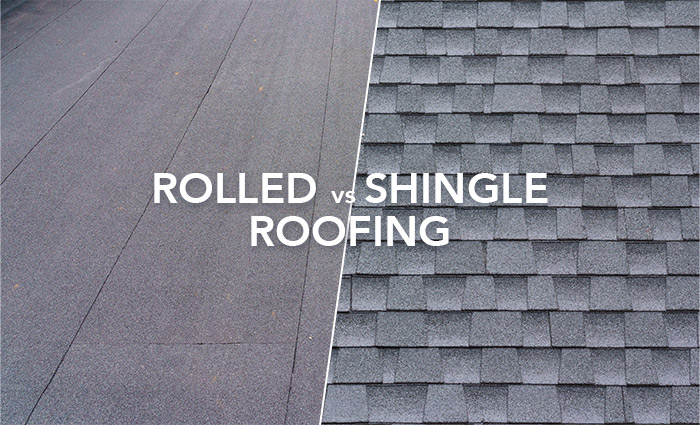
Key Takeaways
- Rolled roofing is a cost-effective, easy-to-install option primarily suitable for low-slope roofs and unoccupied structures, but it has a shorter lifespan and limited aesthetic appeal.
- Asphalt shingles provide greater durability and aesthetic versatility, making them ideal for residential homes; they typically have a longer lifespan than rolled roofing and come at a higher initial cost.
- When selecting roofing materials, key considerations include budget, installation ease, aesthetic preferences, and long-term maintenance and durability.
Overview of Roofing Materials
Rolled roofing and asphalt shingles are two of the most popular choices for residential roofing, each offering distinct advantages. Both are affordable and easy to install, making them ideal for various applications. Rolled roofing is particularly well-suited for low-slope or flat roofs, often used on unoccupied structures like sheds and garages. On the other hand, asphalt shingles are favored for pitched roofs, providing durability and curb appeal for more traditional homes.
Conversely, asphalt shingles are preferred for their versatility, durability, and aesthetic appeal. They adapt to various roof shapes and slopes, offering a durable solution that endures various weather conditions. Factors such as local climate, budget, and personal aesthetic preferences play a significant role in determining which roofing material is the best fit for a particular project.
Grasping the fundamental differences between these roofing options enables a detailed comparison. Each material has its strengths and weaknesses, aiding in a more informed decision for your home.
Characteristics of Rolled Roofing
Rolled roofing is a practical option, particularly for those seeking a cost-effective and simple installation. Commonly used as a temporary fix for low-slope roofs, its simplicity and affordability make it suitable for various applications despite some limitations. Additionally, the roll roof can be an effective choice for similar scenarios.
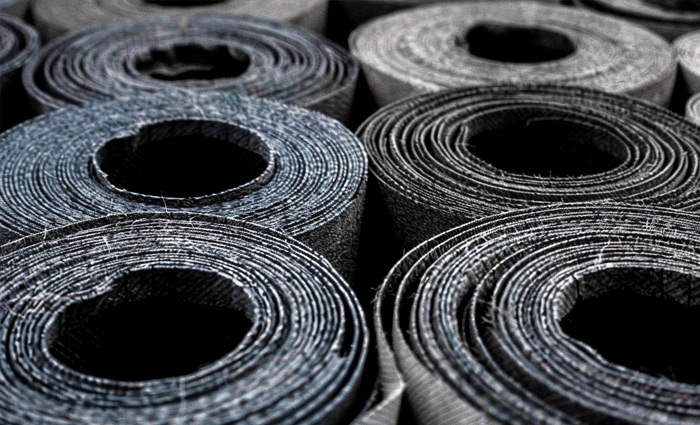
What is Rolled Roofing?
Rolled roofing is a durable and lightweight rolled roofing material that is sold in large rolls. These rolls typically cover about 100 square feet and have a width ranging from 36 to 39 inches. The material itself is composed of oil-based asphalt, reinforced fiberglass, and mineral granules, providing a robust and weather-resistant surface. However, the cons of rolled roofing are that it is unsuitable for roofs with a pitch steeper than 2:12 due to potential drainage issues.
Though less aesthetically pleasing than other materials, its durability and ease of installation make it a practical choice. This simplicity often leads to lower costs and quicker installations, appealing to budget-conscious homeowners.
Applications of Rolled Roofing
Rolled roofing is frequently used for unoccupied buildings like sheds, carports, and workshops due to its cost-effectiveness. Its simple installation and low cost make it suitable for these structures, though it is rarely recommended for residential homes due to aesthetic and drainage concerns.
Typical applications include sheds, treehouses, barns, and other uninhabited outbuildings where aesthetics are less of a concern. Although a quick and economical solution, it’s crucial to consider the downsides of rolled roofing, particularly if seeking a long-term, visually appealing option.
Characteristics of Asphalt Shingles
Asphalt shingles, often called composition shingles, are widely used in residential roofing for their versatility and durability. Composed of a fiberglass base, asphalt coating, and ceramic granules, they offer a robust, weather-resistant solution.
Unlike rolled roofing, asphalt shingles consist of individual overlapping elements, usually flat and rectangular, which can be customized to fit almost any shingle roofing pitch.
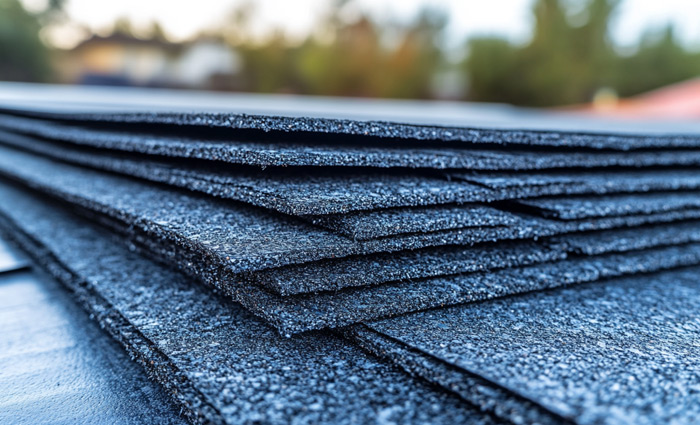
Types of Asphalt Shingles
Several types of asphalt shingles are available, each offering unique style, cost, and durability benefits. Common types include three-tab shingles, architectural shingles, and premium shingles. Three-tab shingles are cost-effective and simple, popular among budget-conscious homeowners. Architectural shingles offer enhanced durability and aesthetics, providing a more appealing, longer-lasting solution.
Relatively easy to install without special tools, asphalt shingles can reduce installation costs. Their wide range of styles, colors, and textures allows for customization to fit personal aesthetic preferences.
Applications of Asphalt Shingles
Asphalt shingles are ideal for residential homes and are versatile and suitable for most roof shapes, slopes, and climates. They offer a durable and visually appealing solution, with architectural shingles lasting between 30 and 50 years, significantly outlasting standard shingles.
Their broad application range and diverse designs make asphalt shingles popular for enhancing aesthetic appeal and durability. Whether opting for budget-friendly three-tab shingles or premium architectural shingles, asphalt shingles meet nearly every roofing need.
Cost Comparison: Rolled Roofing vs Shingles
Cost is a significant factor when choosing between rolled roofing and asphalt shingles. Rolled roofing is generally cheaper in both material and installation, appealing to budget-conscious homeowners.
However, long-term costs, including maintenance and replacement, should be considered as they can accumulate over time.
Rolled Roofing Cost
Typically, installing rolled roofing costs between $1.50 and $3.00 per square foot. Professional installation may raise this to $2.50 to $5.00 per square foot. Additionally, removing an existing roof can cost between $2.50 and $5.50 per square foot.
Modified bitumen roofing, a more durable type of rolled roofing, costs $3 to $5 per square foot for new installations and $4 to $8 per square foot when removing an existing roof.
Asphalt Shingle Costs
The cost of asphalt shingles varies widely based on type and quality. Here’s a breakdown of the costs:
- Low-end shingles: $3 to $4 per square foot
- Architectural shingles (offering enhanced durability and aesthetics): $4 to $8 per square foot
- High-end shingles (providing premium quality and a longer lifespan): $6 to $12 per square foot
Although generally more expensive than rolled roofing, the longer lifespan and higher durability of asphalt shingles can make them more cost-effective in the long run.
Durability and Lifespan
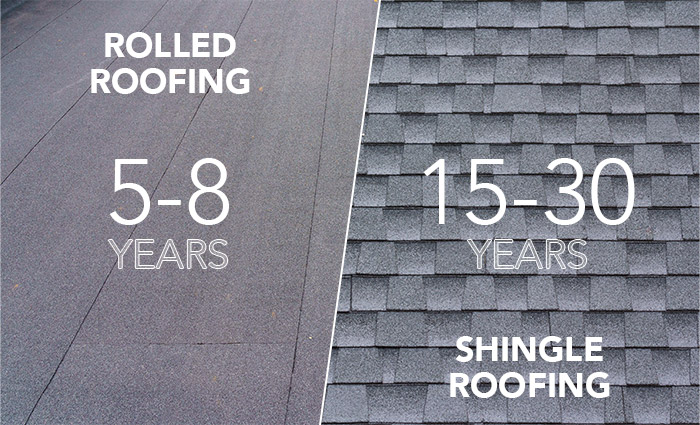
Durability and lifespan are crucial factors in roofing materials. Rolled roofing is generally less durable than asphalt shingles, making it a short-term solution for many.
Conversely, asphalt shingles offer greater durability and can withstand various weather conditions, including extreme temperature changes, high winds, and hail.
Rolled Roofing Lifespan
Rolled roofing typically lasts between five to eight years. Regular inspections and maintenance can extend this lifespan, ensuring effective performance. It is mainly recommended for unoccupied structures, which can prolong its effectiveness.
Given its shorter lifespan, rolled roofing is generally viewed as a temporary solution rather than a long-term investment.
Asphalt Shingle Lifespan
Asphalt shingles are built to withstand various weather conditions, including heat, sunlight, and freezing temperatures. Their expected lifespan ranges from 15 to 30 years, with premium architectural shingles capable of lasting between 30 and 50 years. This longer lifespan makes them a more durable, long-term solution compared to rolled roofing.
Regular maintenance and occasional repairs help asphalt shingles maintain their durability and longevity.
Aesthetic Appeal and Style Options
Aesthetic appeal and style options significantly influence a homeowner’s decision. Rolled roofing is generally perceived as less visually appealing than traditional shingles.
Visual Appeal of Rolled Roofing
Rolled roofing has aesthetic limitations, with limited style and color options, typically available in black, white, tan, gray, and green. Modified bitumen may come with or without a mineral coating, impacting its appearance.
These limitations make rolled roofing a less attractive option for residential homes, especially compared to other roofing materials.
Style Variety in Asphalt Shingles
Asphalt shingles come in a diverse array of designs, allowing homeowners to achieve unique looks with various textures and styles. This variety makes asphalt shingles popular for enhancing a home’s aesthetic appeal.
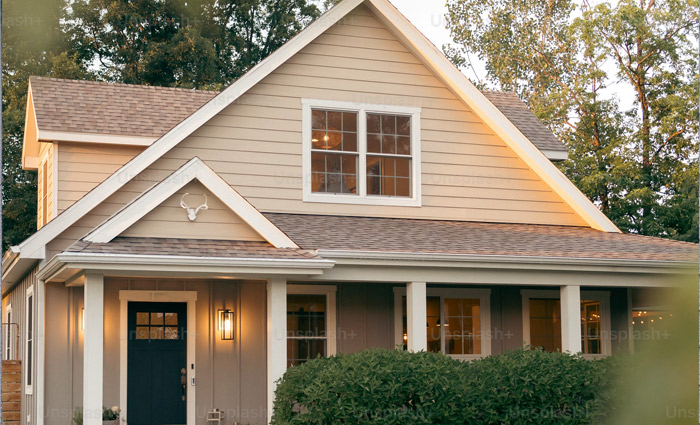
Installation Process
The installation process is an important factor for homeowners. Rolled roofing can be installed over existing roofs if properly prepared, often within a few hours, making it a quick and easy solution. This simplicity often results in lower costs and less time compared to shingles.
Installing Rolled Roofing
Rolled roofing suits low-sloped roofs but is not recommended for flat roofs due to potential leaks. It can be easily installed by DIY enthusiasts, making it popular for saving on installation costs. It can be installed over existing shingles if the surface is prepared correctly.
The process involves applying a primer or sealer to the wood surface to prevent leaks. The simplicity of rolled roofing installation often doesn’t require nails.
Installing Asphalt Shingles
The installation of asphalt shingles is more complex compared to other materials. Professional help is often recommended due to the complicated procedures involved.
Maintenance Requirements
Maintenance is crucial for ensuring the longevity and performance of roofing materials. Rolled roofing requires regular inspections to detect and address potential environmental damage.
Maintaining Rolled Roofing
Regular cleaning of rolled roofing is necessary to remove dirt and debris and maintain integrity. Treatment may be needed to combat moss and algae growth, especially in shaded and damp environments.
Regular maintenance is essential for ensuring the longevity of rolled roofing.
Maintaining Asphalt Shingles
Routine inspections of asphalt shingles help catch and repair issues early. Cleaning gutters and downspouts to prevent water buildup protects shingles from water damage.
Basic tools can easily repair damaged asphalt shingles, making maintenance straightforward.
Environmental Impact
The environmental impact of roofing materials is significant for many homeowners. They take about 300 years to decompose in landfills, significantly contributing to waste, with a recycling rate of only about 1%.
In contrast, rolled roofing generates less waste due to its cut-to-size capability. A protective coating can extend its lifespan by enhancing resistance to UV damage and water.
Making an Informed Decision
Choosing between rolled roofing and asphalt shingles requires considering several factors. Budget is often primary, with rolled roofing being initially more cost-effective. However, personal aesthetic preferences are crucial; many find asphalt shingles more visually appealing.
The decision should also weigh the pros and cons of each material. Rolled roofing is easier to install and cheaper but has a shorter lifespan and fewer style options. Though more expensive, asphalt shingles offer a longer lifespan, better durability, and greater aesthetic flexibility. Assessing these factors based on your specific needs will guide an informed decision.
Roll Roofing vs Asphalt Shingle Summary
In summary, both rolled roofing and asphalt shingles have their unique advantages and disadvantages. Rolled roofing is ideal for temporary solutions and unoccupied structures due to its low cost and easy installation. However, its shorter lifespan and limited aesthetic appeal make it less suitable for residential homes.
On the other hand, asphalt shingles offer greater durability and a wide range of styles, making them a popular choice for residential roofs. While they are more expensive initially, their longer lifespan and lower maintenance needs can make them a more cost-effective choice in the long run. Ultimately, the right choice depends on your specific needs, budget, and aesthetic preferences.
Roll Roofing vs Shingle Frequently Asked Questions
What is the main difference between rolled roofing and asphalt shingles?
The main difference between rolled roofing and asphalt shingles is that rolled roofing is a single sheet designed for low-slope roofs and temporary use, whereas asphalt shingles are individual overlapping pieces that provide enhanced durability and a wider range of aesthetic choices.
How long do asphalt shingles typically last?
Asphalt shingles typically last between 15 to 30 years, while premium architectural shingles can last up to 50 years under ideal conditions. Proper maintenance and climate factors significantly influence their longevity.
Can rolled roofing be installed over existing shingles?
Yes, rolled roofing can be installed over existing shingles if the surface is adequately prepared to ensure proper adhesion. Proper installation will provide a durable roofing solution.
What are the maintenance requirements for rolled roofing?
Regular inspections to remove debris and monitor for damage are essential for maintaining rolled roofing. Additionally, treatment for moss and algae growth may be required in damp conditions.
Are asphalt shingles environmentally friendly?
Asphalt shingles are not environmentally friendly, as they release pollutants during production and take around 300 years to decompose in landfills. Alternatives such as metal or wood shakes are more sustainable options.
(352) 293-2449